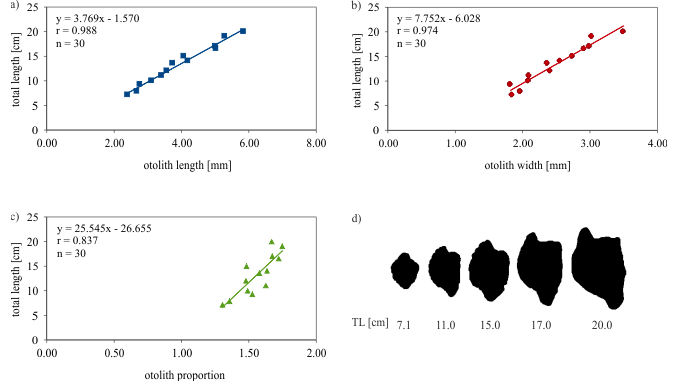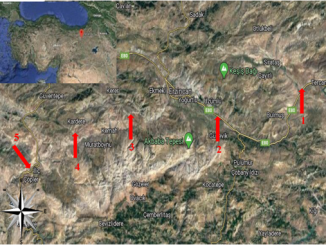
Paper category: Short communication
Corresponding author: Mariusz R. Sapota (mariusz.sapota@ug.edu.pl)
DOI: 10.2478/ohs-2019-0027
Received: 06/11/2018
Accepted: 15/03/2019
Full text: here
Citation (APA style): R. Sapota, M. & Dąbrowska, V. (2019). Shapes of otoliths in some Baltic fish and their proportions. Oceanological and Hydrobiological Studies, 48(3), pp. 296-304. Retrieved 3 Oct. 2019, from doi:10.2478/ohs-2019-0027
Abstract
Otoliths are bony structures inside the fish labyrinth. They are used to determine the age of fish and to identify species based on their remains. The objective of this study was to describe the shape of otoliths in adult European perch (Perca fluviatilis), Atlantic herring (Clupea harengus), European sprat (Sprattus sprattus), lesser sand eel (Ammodytes tobianus), great sand eel (Hyperoplus lanceolatus), round goby (Neogobius melanostomus), European whitefish (Coregonus lavaretus), Atlantic cod (Gadus morhua), haddock (Melanogrammus aeglefinus), European eel (Anguilla anguilla), viviparous eelpout (Zoarces viviparus), turbot (Scophthalmus maximus), European flounder (Platichthys flesus), European plaice (Pleuronectes platessa) and European smelt (Osmerus eperlanus). Fish were caught in the Gulf of Gdańsk. The relationships between the size of otoliths and the length of fish were established for adult European perch, European flounder, Atlantic herring and round goby. Otoliths of taxonomically related species were similar. It was not possible to differentiate otoliths of Ammodytidae, Pleuronectidae, Scophthalamidae, Anguilidae by comparing the presented results with the literature data. Otoliths of Zoarcidae, Osmeridae, Clupeidae, Gadidae, Gobiidae, Percidae and Salmonidae were quite similar but distinguishable. In most of the investigated species, otoliths grow proportionally to the fish size. Their shape does not change during the fish life. The shape of otoliths in the round goby changes significantly. Otoliths of small fish are rounded and significantly lengthen during the growth of fish.
References
Bird, J.L., Eppler, D.T. & Checkley Jr, D.M. (1986). Comparisons of herring otoliths using Fourier series shape analysis. Canadian Journal of Fisheries and Aquatic Sciences 43(6): 1228–1234. DOI: 10.1139/f86-152.
Bostanci, D. (2009). Otolith biometry-body length relationships in four fish species (chub, pikeperch, crucian carp, and common carp). Journal of Freshwater Ecology 24(4): 619–624. DOI: 10.1080/02705060.2009.9664339.
Bowen, W.D. (2000). Reconstruction of pinniped diets: accounting for complete digestion of otoliths and cephalopod beaks. Canadian Journal of Fisheries and Aquatic Sciences 57(5): 898–905. DOI: 10.1139/f00-032.
Burke, N., Brophy, D. & King, P.A. (2008). Shape analysis of otolith annuli in Atlantic herring (Clupea harengus); a new method for tracking fish populations. Fisheries Research 91(2–3): 133–143. DOI: 10.1016/j.fishres.2007.11.013.
Campana, S.E. (2004). Photographic Atlas of Fish Otoliths of the Northwest Atlantic Ocean. Ottawa, Ontario: NRC Research Press.
Campana, S.E. & Casselman, J.M. (1993). Stock discrimination using otolith shape analysis. Canadian Journal of Fisheries and Aquatic Sciences 50(5): 1062–1083. DOI: 10.1139/f93-123.
Capoccioni, F., Costa, C., Aguzzi, J., Menesatti, P. & Lombarte, A. (2011). Ontogenetic and environmental effects on otolith shape variability in three Mediterranean European eel (Anguilla anguilla, L.) local stocks. Journal of Experimental Marine Biology and Ecology 397(1): 1–7. DOI: 10.1016/j.jembe.2010.11.011.
Cardinale, M., Doering-Arjes, P., Kastowsky, M. & Mosegaard, H. (2004). Effects of sex, stock, and environment on the shape of known-age Atlantic cod (Gadus morhua) otoliths. Canadian Journal of Fisheries and Aquatic Sciences 61(2): 158–167. DOI: 10.1139/f03-151.
Cruz, A. & Lombarte, A. (2004). Otolith size and its relationship with colour patterns and sound production. Journal of Fish Biology 65(6): 1512–1525. DOI: 10.1111/j.0022-1112.2004.00558.x.
Folkvord, A., Johannessen, A. & Moksness, E. (2004). Temperature-dependent otolith growth in Norwegian spring-spawning herring (Clupea harengus L.) larvae. Sarsia 89(5): 297–310. DOI: 10.1080/00364820410002532.
Friedland, K.D. & Reddin, D.G. (1994). Use of otolith morphology in stock discriminations of Atlantic salmon (Salmo salar). Canadian Journal of Fisheries and Aquatic Sciences 51(1): 91–98. DOI: 10.1139/f94-011.
Galley, E.A., Wright, P.J. & Gibb, F.M. (2006). Combined methods of otolith shape analysis improve identification of spawning areas of Atlantic cod. ICES Journal of Marine Science. 63(9): 1710–1717. DOI: 10.1016/j.icesjms.2006.06.014.
Gierl, C., Reichenbacher, B., Gaudant, J., Erpenbeck, D. & Pharisat, A. (2013). An extraordinary gobioid fish fossil from southern France. PloS one 8(5): e64117. DOI: 10.1371/journal.pone.0064117.
ICM, CSIC, UPC, UVIC. (2017, November). Shape Analysis of Fish Otoliths. Retrived February 16, 2018, from http://isis.cmima.csic.es/aforo/startDB_en.jsp.
Jobling, M. & Breiby, A. (1986). The use and abuse of fish otoliths in studies of feeding habits of marine piscivores. Sarsia 71(3–4): 265–274. DOI: 10.1080/00364827.1986.10419696.
Joyce, W.N., Campana, S.E., Natanson, L.J., Kohler, N.E., Pratt Jr, H.L. et al. (2002). Analysis of stomach contents of the porbeagle shark (Lamna nasus Bonnaterre) in the northwest Atlantic. ICES Journal of Marine Science 59(6): 1263–1269. DOI: 10.1006/jmsc.2002.1286.
Merigot, B., Letourneur, Y. & Lecomte-Finiger, R. (2007). Characterization of local populations of the common sole Solea solea (Pisces, Soleidae) in the NW Mediterranean through otolith morphometrics and shape analysis. Marine Biology 151(3): 997–1008. DOI: 10.1007/s00227-006-0549-0.
Morrow, J.E. (1979). Preliminary keys to otoliths of some adult fishes of the Gulf of Alaska, Bering Sea, and Beaufort Sea. Washington, DC: U.S. Department of Commerce, NOAA, NMFS. (NOAA Technical Report NMFS Circular, 420).
Mosegaard, H., Svedäng, H. & Taberman, K. (1988). Uncoupling of somatic and otolith growth rates in Arctic char (Salvelinus alpinus) as an effect of differences in temperature response. Canadian Journal of Fisheries and Aquatic Sciences. 45(9): 1514–1524. DOI: 10.1139/f88-180.
Olsson, O. & North, A. W. (1997). Diet of the king penguin Aptenodytes patagonicus during three summers at South Georgia. Ibis 139(3): 504–512. DOI: 10.1111/j.1474-919X.1997.tb04666.x.
Paxton, J. R. (2000). Fish otoliths: do sizes correlate with taxonomic group, habitat and/or luminescence? Philosophical Transactions of the Royal Society of London B: Biological Sciences 355(1401): 1299–1303. DOI: 10.1098/rstb.2000.0688.
Phillips, K.L., Jackson, G.D. & Nichols, P.D. (2001). Predation on myctophids by the squid Moroteuthis ingens around Macquarie and Heard Islands: stomach contents and fatty acid analyses. Marine Ecology Progress Series 215: 179–189. DOI: 10.3354/meps215179.
Pothin, K., Gonzalez‐Salas, C., Chabanet, P. & Lecomte‐Finiger, R. (2006). Distinction between Mulloidichthys flavolineatus juveniles from Reunion Island and Mauritius Island (south‐west Indian Ocean) based on otolith morphometrics. Journal of Fish Biology 69(1): 38–53. DOI: 10.1111/j.1095-8649.2006.01047.x.
Poulet, N., Berrebi, P., Crivelli, A.J., Lek, S. & Argillier, C. (2004). Genetic and morphometric variations in the pikeperch (Sander lucioperca L.) of a fragmented delta. Archiv für Hydrobiologie 159(4): 531–554. DOI: 10.1127/0003-9136/2004/0159-0531.
Reay, P.J. (1972). The Seasonal Pattern of Otolith Growth and its Application to Back-Calculation Studies in Ammodytes tobianus L. ICES Journal of Marine Science 34(3): 485–504. DOI: 10.1093/icesjms/34.3.485.
Svetocheva, O., Stasenkova, N. & Fooks, G. (2007). Guide to the otoliths of the bony fishes of the White Sea. Arkhangelsk: IMR/PINRO Joint Report Series No. 3/2007.
Tollit, D.J., Steward, M.J., Thompson, P.M., Pierce, G.J. & Santos, M.B. (1997). Species and size differences in the digestion of otoliths and beaks: implications for estimates of pinniped diet composition. Canadian Journal of Fisheries and Aquatic Sciences 54(1): 105–119. DOI: 10.1139/f96-264.
Tracey, S.R., Lyle, J.M. & Duhamel, G. (2006). Application of elliptical Fourier analysis of otolith form as a tool for stock identification. Fisheries Research 77(2): 138–147. DOI: 10.1016/j.fishres.2005.10.013.
Turan, C. (2000). Otolith shape and meristic analysis of herring (Clupea harengus) in the North-East Atlantic. Archive of Fishery and Marine Research 48(3): 213–225.
Tuset, V.M., Rosin, P.L. & Lombarte, A. (2006). Sagittal otolith shape used in the identification of fishes of the genus Serranus. Fisheries Research 81(2): 316–325. DOI: 10.1016/j.fishres.2006.06.020.
Vignon, M. (2012). Ontogenetic trajectories of otolith shape during shift in habitat use: Interaction between otolith growth and environment. Journal of Experimental Marine Biology and Ecology 420: 26–32. DOI: 10.1016/j.jembe.2012.03.021.
Yilmaz, S., Yazicioglu, O., Saygin, S. & Polat, N. (2014). Relationships of otolith dimensions with body length of European perch, Perca fluviatilis L., 1758 from Lake Ladik, Turkey. Pakistan Journal of Zoology 46(5): 1231–1238.


Bądź pierwszy, który skomentuje ten wpis